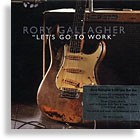
Rory Gallagher’s mention brings a certain vision: denim jeans and a flannel shirt. An old Strat with very little finish left. High-spirited yet authentic blues and rock. Consummate musicianship. A CD box set also brings a certain vision: packaging the music parts into a greater whole.
Both are represented clearly in this new offering. Gallagher, the Irish troubadour-turned-working-class guitar hero, is fully represented on four live CDs. Three are previously released, the fourth only in bootleg form. And that’s where the packaging comes in.
The box (and unlike some box sets there really is a box) is filled with unpublished photos and an excellent booklet with extensive and complete notes about Gallagher and crew. They document a guitar-playing songwriter who charted his own path until a his death at age 46. Gallagher also assumed complete creative control of his music, produced all his recordings, and generally set the tone and direction for his career. He fronted one of the first power trios, Taste, in the 1960s, broke out as a solo artist in ’71 and got radio airplay on album-friendly stations, then became a big draw on college campuses across the U.S. His following in Europe was even larger, and he recorded and toured regularly until the late ’80s, when health problems forced a cutback.
Firmly grounded in the blues, but also informed by a jazz sensibility, Gallagher performed mainly his own compositions, which took the form of revved-up rockers mixed with slower 12-bar fare. Even so, Gallagher was proficient in acoustic, electric, and bottleneck guitar as well as mandolin, harmonica, and even saxophone. It’s a shame he left us before the “unplugged” trend, as he would have been a true force as a solo acoustic performer.
Indeed, Gallagher became known for the one electric guitar he was to use for his entire career, a late-’50s Fender Stratocaster with a rosewood fingerboard. The guitar lost nearly all of its finish over the decades of studio and road work, as Gallagher used it for nearly every live performance and recording session. No switching guitars in concert – he simply re-tuned the Strat to an open key and took off.
While he was occasionally spotted with a Telecaster, it was the prized Strat, that was the main axe. His amp selection was just as simple – a tube amp by Fender, Vox, or occasionally Marshall, and nothing but a cord between guitar and amp.
The music in this set captures Gallagher at his best and can be broken into four distinct periods. First is the original Rory Gallagher Live from ’73, which has Gallagher in his trio format. Another great packaging trick is employed in the form of previously unreleased bonus tracks, two on this CD. Several covers spice up the works, but it’s the encore number “Bullfrog Blues” that best defines the Gallagher sound and fury and also features brief bass and drum solos. Gallagher uses the Strat, mandolin, and Dobro to full effect on this CD, and shows that a trio can be as much of a band as one could need. But when a second live album was recorded only a couple of years later, a keyboard player had been added to the mix. Whether the electric piano improved the overall sound is debatable, but the energy on Irish Tour ’74 is compelling, either because Gallagher had returned home or because it was one of those special nights, the tracks here burn.
Irish Tour ’74 captured Rory doing what he does best, with a bevy of original numbers, the standout being a power ballad, “A Million Miles Away.” It’s a tour de force number about sitting in a bar but dreaming of being somewhere else, and features Gallagher’s patented volume swells, squawking lead-position Strat solos, and pinched harmonics.
The third CD is Gallagher’s original 1980 release, Stage Struck . Overall, this is a more straightforward rock record than the previous live offerings, which tended to mix tempo and instruments. CD number four is the new and aptly titled Meeting with the G-Man which was recorded in 1993 and, while bootlegged with dubious quality, is previously unreleased. The performance is surprisingly strong, coming as it did two years before Gallagher’s death, and song selection is more varied and with more covers. Gallagher’s production dropped off sharply in the ’80s, so there were few new originals. He even covers “La Bamba” and the Beatles’ “Revolution.” Sound quality is excellent, and the performance is energetic.
Again, packaging is a key in re-releases. In this case the original album covers are used for each CD and each mini-album has a slip case featuring one of Rory’s well-used amps. With Live in Europe it’s an old Vox AC-30, Irish Tour has a tweed Twin, Stage Struck features old Marshall combo, and G-Man shows the battle-scarred Strat. There are also two photo cards of Gallagher.
Another mark of the box set is sound quality, and this set delivers with a three original discs fully remastered and the final disc with excellent sound. At present, this box set is only available by import. This may have as much to do with Gallagher’s overseas following as its comparative lack in the U.S.
The live Gallagher was certainly a force, but his studio work is much more diverse and deserves equal scrutiny. One can hope that a complete retrospective is in the works. He didn’t have hits, he wasn’t the most popular, and lots of people never really heard his music, but Gallagher was a musician and performer of the highest caliber and he may yet get his day in the sun as more about his life and music is presented to a new generation.
This article originally appeared in VG‘s March ’03 issue. All copyrights are by the author and Vintage Guitar magazine. Unauthorized replication or use is strictly prohibited.



